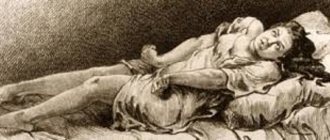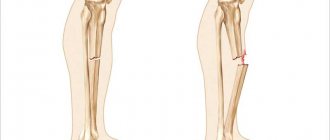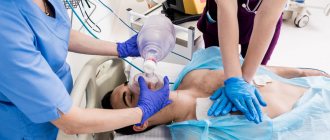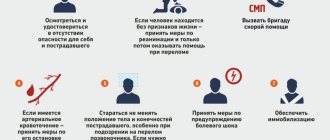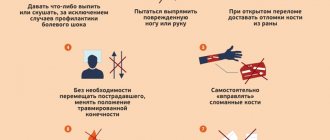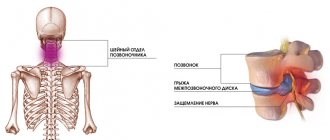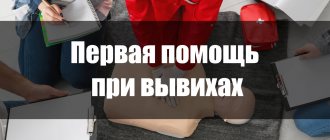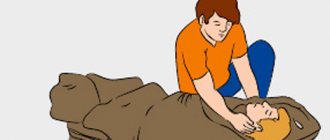A pinched nerve in the shoulder joint is a common problem. Many people confuse it with the inflammatory process, although these are two different neurological diseases that have similar symptoms. At the same time, experts note that if treatment is not timely, pinching can lead to the development of an inflammatory process. To avoid such a complication, you need to pay attention to the first symptoms and seek qualified help from a specialist.
The nerve can become pinched when bone spurs begin to appear around the spinal disc. The discs act as some kind of “shock absorbers” between the vertebrae in the spinal column. Bone spurs are new bone formations. They begin to grow when the discs weaken significantly and wear out over time. As we age, the vertebrae become compressed and the discs become thinner. Bone spurs grow around the discs to strengthen them. However, this bone growth can put negative pressure on the nerve root in the spinal column.
What causes lower back pain?
Most often, a pinched lower back takes you by surprise: it becomes painful to move, and the person panicsly tries to figure out what to do. This condition can be avoided by knowing in advance what reasons lead to an unpleasant ending. Here are some of the most common factors:
- Inadequate physical activity. For example, lifting heavy weights, especially in people with little training.
- Displacement of the lumbar vertebrae, dislocation, and other dangerous back injuries.
- Hypothermia, prolonged exposure to low temperatures (for example, in water).
- Neoplasms of various types.
- Osteochondrosis. Calcification of bone tissue and thinning of the cartilage of the intervertebral discs lead to a reduction in the distance between the vertebral bodies. Because of this, the nerve roots coming out of the spinal cord are pinched.
- Protrusion of an intervertebral disc into the spinal canal (protrusion) or outward, with a herniated intervertebral disc. Even if the integrity of the cartilaginous ring is preserved, mobility is greatly affected.
- Overweight. Additional kilograms increase the load on the spinal column. The process develops in a similar way when carrying a child, when additional kilograms and a shift of weight forward, onto the stomach, can lead to compression of the nerves.
- Lack of vitamins and minerals. It occurs due to poor nutrition and leads to degenerative changes in the bones, including the development of osteoporosis.
- Incorrect posture, scoliosis, stoop.
- Sedentary work, lack of mobility. An uncomfortable sleeping place, leading to an unnatural posture in which the spine cannot fully straighten.
Signs of a pinched nerve in the lower back occur with pathological changes in the spine and intervertebral discs. The condition can be provoked by infectious diseases, degenerative changes in bone and cartilage tissue. Tolerating the sensations and hoping that it will go away on its own, or to self-medicate, is dangerous. It is necessary to find out why the disease occurred. Therefore, you need to contact doctors who specialize in treating the spine and joints. They recognize the problem in time and find a way to keep the patient healthy.
Diagnosis of pathology
Neuralgia is often confused with neuritis (the development of an inflammatory process) because they have similar symptoms. Despite the fact that these are different pathologies, with inadequate and untimely treatment, there is a high probability that the pinched nerve will become inflamed. In addition, a pinched nerve has similar symptoms in various disorders of the cardiovascular system, when there are problems with blood circulation and oxygen supply to the fibers.
To establish that the source of pain and other symptoms lies precisely in the pinching, you need to contact a qualified specialist. At the initial appointment, he will listen to all the patient’s complaints, collect anamnesis and conduct a neurological examination. To do this, finger sensitivity and tendon reflexes will be tested. If there is pinching, the patient will not be able to spread the thumb and little finger apart. Problems will also arise with clenching all your fingers into a fist.
The essence of another diagnostic method is to check for hanging hand syndrome. It will be confirmed in the situation if, with the arm extended in a horizontal position, a person is unable to hold the hand parallel to the floor. Additionally, in order to make a reliable diagnosis and differentiate it from other diseases, a neurologist will prescribe an instrumental examination. It will also help determine the underlying cause of the nerve compression. The following techniques may be prescribed to the patient:
- X-ray examination. This is the simplest type of instrumental examination. Doctors prescribe it first. The study does not take much time and has virtually no contraindications. Based on the results of the obtained x-ray, it is possible to detect a number of degenerative diseases, osteophytes, cysts and other tumors (benign and malignant);
- ultrasonography. As a rule, it is resorted to only when there are suspicions of disturbances in the functioning of the cardiovascular system. This technique is quite mobile, accessible, it is characterized by the absence of painful sensations and the speed of implementation;
- computed tomography (CT). This is a more informative technique compared to radiographic examination. It clearly visualizes the bone structures of the spine and allows one to determine the possibility of bone displacement. Computed tomography is highly effective and allows you to determine the degree of nerve pinching;
- magnetic resonance imaging (MRI). This diagnostic method is completely safe for the patient. There are no painful sensations during the examination. The number of contraindications is minimal. Magnetic resonance imaging makes it possible to detect the cause that provoked the development of the disease. It well reflects the structure of the tissues of the shoulder joint and the condition of nearby tissues.
Laboratory testing is used as an auxiliary diagnostic method, since it does not provide a detailed picture of the clinical picture. However, a general blood test can detect neuritis (the development of an inflammatory process). In this case, the number of leukocytes in the patient's blood will increase.
Types and symptoms of the disease
In addition to intense pain that can radiate to the legs or arms, there are many indirect signs of lumbar disease. When determining whether a nerve is pinched in the lower back, one should focus both on the intensity of the pain syndrome and on other signs that have arisen in areas of the body remote from the epicenter:
- lower back pulls and burns;
- the leg (or both legs) is numb, and the sensation does not go away for several days;
- a certain muscle group moves poorly;
- the gait became uncertain, constrained, shaky;
- state of general weakness, rapid fatigue;
- the pain intensifies not only with movement, but also with coughing, sneezing, even laughing;
- if the nerve branch that goes to the internal organs is pinched, the heart, intestines, and stomach can hurt.
The pain is always present. The intensity depends on how much the nerves responsible for pain sensitivity are involved. Typically, a whole bundle of nerves is subjected to pressure, causing several symptoms at once.
Principles of treatment
The lumbar region consists of five vertebrae. Depending on the location of the problem, the types of disease and methods of treating the consequences of a pinched spinal nerve differ. Doctors differentiate sciatica, lumbago, and lumboischialgia. Sciatica is characterized by pain in the areas of the sacrum and gluteal muscles. The legs usually shoot in the posterior projection. The sensations are intense; between attacks, the patient experiences fear of a new attack, which leads to constant stress and chronic fatigue.
Lumbago is determined by throbbing pain in the lower back. It often occurs during a sharp turn or tilt. With lumboischialgia, pain varies in intensity, is transmitted to the leg and back of the thigh, movements become constrained. Sciatica or inflammation of the sciatic nerve occurs against the background of a hernia, infectious diseases, and diabetes.
When deciding what to do if a nerve is pinched in your back, you need to remember: see a doctor. Pinched nerve cells do not receive nutrition, they can begin to die, which will lead to serious consequences, including paralysis.
When deciding how to relieve a patient from the consequences of a pinched nerve in the lower back, doctors recommend complex treatment, which consists of providing competent first aid, specific studies, drug and non-drug therapy and mandatory rehabilitation:
- To alleviate the condition, before the doctor arrives, it is necessary to remove all loads, protect the patient from drafts and cold, lay him on a flat mattress, bandage his back with a scarf or handkerchief, and, if necessary, give an analgesic.
- At the doctor's discretion, a number of studies are carried out: medical history, x-rays, CT, MRI, and other hardware methods. This is necessary to make an accurate diagnosis.
- The doctor prescribes specific medications and diet. At first, bed rest is observed.
If conservative methods do not help, surgery is prescribed. Sometimes surgery becomes necessary to relieve the effects of a hernia or nerve damage. After the acute phase of the disease passes, auxiliary measures and restorative procedures begin.
Pathophysiology
By its nature, nerve damage can be either ischemic or mechanical.
Repeated injury and trauma to the nerve can lead to microvascular (ischemic) changes, swelling, damage to the outer layers of the nerve (the myelin sheath) that facilitate the transmission of nerve impulses, and structural changes in membranes at the organelle level (both the myelin sheath and the nerve axon) . Focal segmental demyelination in the area of compression is a common feature of compression syndromes. Full restoration of function after surgical decompression is associated with remyelination of the injured nerve. Incomplete recovery occurs due to Wallerian axonal degeneration and persistent fibrotic changes at the neuromuscular junction, which may prevent complete reinnervation and restoration of function.
Recovery from lumbar compression
To release a pinched nerve in the lower back, medication and diet are not enough. A set of additional classes is required. Physiotherapy treatments may be combined with massage specifically designed to help relieve pinched nerves in the lower back. Mud therapy and therapeutic exercises are also used. All measures are aimed at restoring mobility, strengthening muscles, and improving blood supply.
Special exercises to develop the lower back when a nerve is pinched consist of light daily exercise, swimming (necessarily in conditions of a comfortable water temperature). You should absolutely not overload your back. The patient should enjoy performing the techniques, then he will get used to leading an active lifestyle and benefit from it.
In addition to exercise therapy with a trainer, it is useful to perform some movements at home as exercise. The simplest of them are:
- bending forward, to the sides (small amplitude);
- walking with knees pulled up;
- swinging legs (performed lying down, standing);
- bending and pulling the knee joints to the chest (performed lying down);
- clasping your knees with your hands, rolling back and forth on your back;
- twisting the torso to the right, to the left (lying on the mat).
Each session lasts at least ten minutes. At the same time, blood flow and lymph outflow improve, muscles relax, and oxygen supply to tissues increases.
Gymnastics will benefit any person who complains that his back is stuck in the lower back and he does not know what to do in such cases. If there are no serious pathologies, regular exercise will serve as good prevention.
Massage and manual therapy for pinched nerves in the back should be carried out by a specialist with a medical education. You only need to contact professionals so as not to make things worse.
Prevention as the main means of fighting for spinal health
The question is often asked on the Internet: What to do if your back is locked? Most come to their senses only when the disaster has already happened. But the human body has a huge reserve of strength and the ability to heal itself. Therefore, preventive measures will help prevent muscle spasms, thinning of the cartilage layers, the occurrence of a hernia, and maintain healthy coordination of movements.
It's never too late to start. Restorative gymnastics for a pinched nerve in the lower back will help regulate the load and teach the muscles to stay in good shape. Muscle tissue, as the main protector of joints, should remain active at any age. It is especially important to remain active after menopause, when hormonal levels change and there is a predisposition to poor calcium absorption.
Regular training with an experienced mentor will teach you how to properly handle your spine, prevent recurrent attacks, and restore the joy of life, health and vigor.
Preventive actions
As with any pathology, it is much easier to prevent the occurrence than to treat a pinched sciatic nerve. To avoid the onset of disease, it is important to be careful about your health and follow a number of preventive measures. First of all, you need to strengthen your back muscles. To do this, special physical exercises should be carried out (they are selected by the attending physician).
It is necessary to keep your back straight if possible (do not hunch over while walking, do not sit leaning forward). If a person has a sedentary (office) job, he should take breaks - get up and walk around the room for several minutes. Lifting heavy objects is prohibited and only moderate exercise is allowed. Experts do not recommend exposing the spine to heavy physical activity. Girls with problems in the lumbar spine are not recommended to constantly wear high heels. It is important to keep your lower back warm at all times (to avoid hypothermia).

